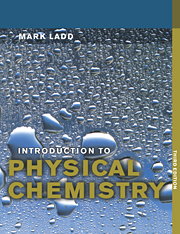Book contents
- Frontmatter
- Contents
- Preface
- Physical constants and other numerical data
- Prefixes to Units
- 1 Structure, energy, mechanism
- 2 Atoms, molecules and their structures
- 3 Determination of structure
- 4 Energy and energetics
- 5 States of matter: gases and liquids
- 6 States of matter: solids
- 7 Phase rule and properties of solutions
- 8 Chemical equilibrium
- 9 Electrochemistry
- 10 Chemical kinetics and mechanisms of chemical reactions
- Appendix 1 Problem-solving with personal computers
- Appendix 2 Stereoviewing
- Appendix 3 Average classical thermal energies
- Appendix 4 Reduced mass
- Appendix 5 Spherical polar coordinates
- Appendix 6 Gamma function
- Appendix 7 Slater's rules
- Appendix 8 Linear least squares and the propagation of errors
- Appendix 9 Determinants and cofactors
- Appendix 10 Solution of a second-order differential equation
- Appendix 11 Separation of variables
- Appendix 12 Overlap integrals
- Appendix 13 Partial derivatives
- Appendix 14 Numerical integration
- Appendix 15 Fermi-Dirac statistics
- Appendix 16 Calculation of Madelung constants
- Appendix 17 The hypsometric formula: an example of the Boltzmann distribution
- Appendix 18 Tables of physical data
- Bibliography
- Answers to numerical problems
- Index
3 - Determination of structure
Published online by Cambridge University Press: 05 June 2012
- Frontmatter
- Contents
- Preface
- Physical constants and other numerical data
- Prefixes to Units
- 1 Structure, energy, mechanism
- 2 Atoms, molecules and their structures
- 3 Determination of structure
- 4 Energy and energetics
- 5 States of matter: gases and liquids
- 6 States of matter: solids
- 7 Phase rule and properties of solutions
- 8 Chemical equilibrium
- 9 Electrochemistry
- 10 Chemical kinetics and mechanisms of chemical reactions
- Appendix 1 Problem-solving with personal computers
- Appendix 2 Stereoviewing
- Appendix 3 Average classical thermal energies
- Appendix 4 Reduced mass
- Appendix 5 Spherical polar coordinates
- Appendix 6 Gamma function
- Appendix 7 Slater's rules
- Appendix 8 Linear least squares and the propagation of errors
- Appendix 9 Determinants and cofactors
- Appendix 10 Solution of a second-order differential equation
- Appendix 11 Separation of variables
- Appendix 12 Overlap integrals
- Appendix 13 Partial derivatives
- Appendix 14 Numerical integration
- Appendix 15 Fermi-Dirac statistics
- Appendix 16 Calculation of Madelung constants
- Appendix 17 The hypsometric formula: an example of the Boltzmann distribution
- Appendix 18 Tables of physical data
- Bibliography
- Answers to numerical problems
- Index
Summary
Introduction
The determination of the structures of chemical species is an important and absorbing aspect of physical chemistry. Many methods have been devised as the subject of structure determination has developed, but among the most rewarding techniques currently in practice are those based either on spectroscopic or on diffraction methods. The extent of each of these fields is considerable, and here we shall introduce only parts of them. It is important in structure determination to acquire a knowledge of symmetry, and the application of symmetry principles in chemistry is far reaching. We give first a brief introduction to the symmetry of three-dimensional, finite bodies and its application in chemistry.
Symmetry concepts
We can see evidence of symmetry all around us; it is not just a feature of molecules and crystals. The emblems associated with the National Westminster Bank plc, the Isle of Man and Mercedes-Benz cars all reveal threefold symmetry; the latter shows other symmetry as well. The splendid Dobermann in Figure 3.1 illustrates reflection symmetry about a vertical, medial plane through her.
A symmetry operation applied to a molecule, or other body, moves it into a state that is indistinguishable from its initial state, thereby revealing the symmetry inherent in the body. We may link a symmetry operation with a symmetry element, which is a conceptual geometrical entity (point, line or plane) with respect to which a symmetry operation may be said to be performed.
Information
- Type
- Chapter
- Information
- Introduction to Physical Chemistry , pp. 83 - 164Publisher: Cambridge University PressPrint publication year: 1998
